![]()
![]()
![]()
Use LEFT and RIGHT arrow keys to navigate between flashcards;
Use UP and DOWN arrow keys to flip the card;
H to show hint;
A reads text to speech;
115 Cards in this Set
- Front
- Back
|
What is parasitism?
|
A type of symbiotic relationship between two different organisms where one organism, the parasite, benefits from the host and the host is harmed
|
|
|
What is symbiosis?
|
Any 2 organisms living in close association, commonly one living in or on the body of the other
|
|
|
What are the types of symbiosis?
|
Phoresis: merely “traveling” together
Mutualism: both benefit Commensalism: one benefits, other unharmed Parasitism: one benefits, other harmed |
|
|
What is predation?
|
Interaction where a predator (hunter) feeds on its prey, which may or may not be killed prior to feeding on them, but the act of predation always results in the death of the prey
|
|
|
What is an ectoparasite?
|
Parasite that lives on the outer surface of its host
|
|
|
What is an endoparasite?
|
Parasite that lives inside its host
|
|
|
What is an obligate parasite?
|
Parasite that cannot complete their life cycle without spending at least part of the time within a parasitic relationship
|
|
|
What is a facultative parasite?
|
Parasites that are not normally parasitic, but can become so when they are accidentally eaten or enter a wound or other body orifice
|
|
|
What is a definitive host?
|
Host in which parasite reaches sexual maturity
|
|
|
What is an intermediate host?
|
A host required for parasite development but in which parasite does not reach sexual maturity
|
|
|
What is a paratenic or transport host?
|
Host in which the parasite does not undergo any development but in which it stays alive and infective to another host
|
|
|
What is a reservoir host?
|
Any animal that harbors an infection that can be transmitted to humans, even if the animal is not a normal host of the parasite
|
|
|
What are macroparasites?
|
Parasites that are large enough to be seen with the naked eye that grow in the host but multiply by producing infective stages that are released from the host, allowing the parasite to spread to other hosts
|
|
|
What are microparasites?
|
Parasite that multiplies directly within their host, usually inside host cells. They can complete a full life cycle inside a single host and generally cannot be seen with the naked eye
|
|
|
Describe the Ideal Parasite.
|
One that that is:
Able to recognize host Able to establish itself in or on host Able to adapt to environment Able to obtain nutrition Able to avoid host immune system Able to reproduce or be transmitted |
|
|
What is a vector?
|
An animal that transmits a parasite
|
|
|
What do the word endings iasis and itis mean?
|
-iasis: disease caused by-
-itis: inflammation of- |
|
|
What is a granuloma?
|
Nodule of scar tissue
|
|
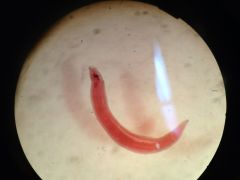
Class/SubClass/Order/Family/Genus/Species
sex Intermediate host(s) in order; final host Disease Mode of infection of final host location egg description Miricidium features? |
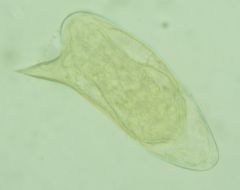
Trematoda Digenea Stregiformes Schistosomatidae Schistosoma mansoni
male Snail; Humans schistosomiasis Skin penetration of Cercaria portal veins in large intestine Africa, East Asia eliptical with lateral spine Apharyngeate |
|
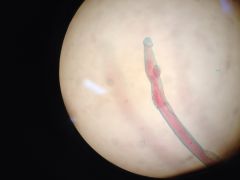
Class/SubClass/Order/Family/Genus/Species
sex Intermediate host(s) in order; final host Disease Mode of infection of final host location egg description Miricidium features? |
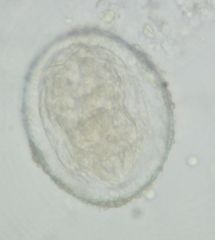
Trematoda Digenea Stregiformes Schistosomatidae Schistosoma japonicum
Snail; Humans schistosomiasis Skin penetration of Cercaria veins of small intestine East Asia Oval, spherical eggs Apharyngeate Bonus: Cercariae have furocercous, or forked tail |
|
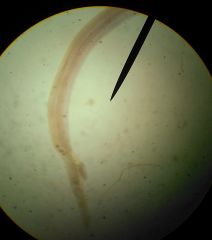
Class/SubClass/Order/Family/Genus/Species
sex Intermediate host(s) in order; final host Disease Mode of infection of final host location egg description Miricidium features? |

Trematoda Digenea Stregiformes Schistosomatidae Schistosoma haematobium
male Snail;Humans schistosomiasis Skin penetration of Cercaria veins of urinary bladder Africa, Middle East eliptical with terminal spine Apharyngeate |
|

Female adults of this Schistosome have long, skinny body, with tail-like appendage
|
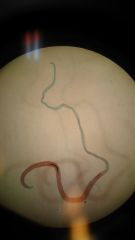
Schistosoma japonicum
|
|
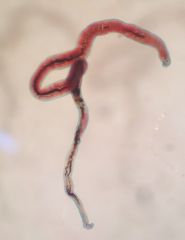
Female adults of this Schistosome are thick and symmetrical.
|
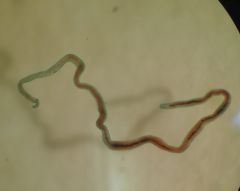
Schistosoma mansoni
|
|
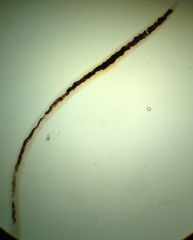
Female adults of this Schistosome are skinniest of the big three.
|
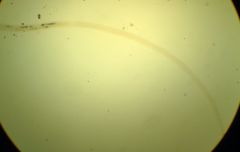
Schistosoma haematobium
|
|
|
This is the basic life cycle of all of the big three Schistosomes.
|
Eggs hatch to miracidia-infect snail-sporocyst-rediae-cercaria break free and penetrate human -become metacercaria and develop to adults in portal blood near liver
|
|
|
This Trematode family includes two gigantic flukes.
|
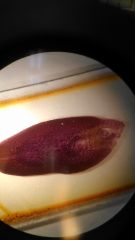
Fasciolidae
includes Fasciola hepatica (pictured), Fasciolopsis buski |
|
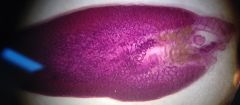
Family/Genus/Species
Intermediate host; final host mode of infection of final host location of infection geography egg description |

Fasciolidae Fasciola hepatica
Snail;Livestock, rabbits, Humans Consumption of metacercariae encysted vegetation Liver World Wide Round and fat Two large testes in adult |
|
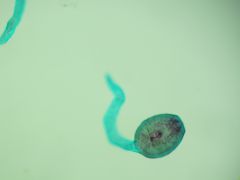
Family Genus species
life stage |
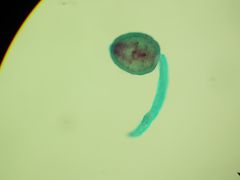
Fasciolidae Fasciola hepatica
Cercaria |
|
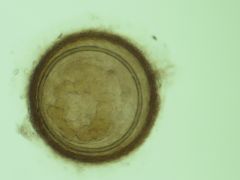
Family Genus species
life stage |
Fasciolidae Fasciola hepatica
Metacercaria |
|
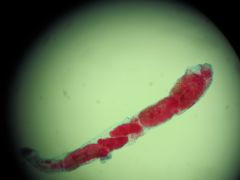
Family Genus species
life stage |
Fasciolidae Fasciola hepatica
redia |
|
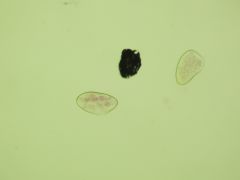
Family Genus species
life stage |

Fasciolidae Fasciola hepatica
eggs |
|
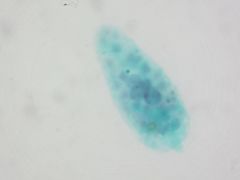
Family Genus species
life stage |

Fasciolidae Fasciola hepatica
miricidium |
|
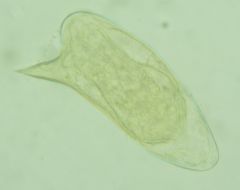
Family Genus species
life stage |
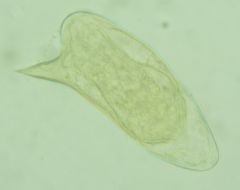
(Trematoda Digenea Stregiformes) Schistosomatidae Schistosoma mansoni
egg, note lateral spine |
|
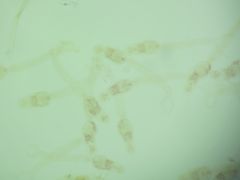
Family Genus species
life stage |
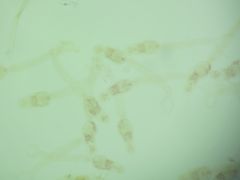
(Trematoda Digenea Stregiformes) Schistosomatidae Schistosoma mansoni
cercaria (pl. cercariae) Note forked tails. (Furocercous) |
|
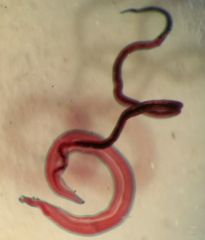
Famile Genus species
|
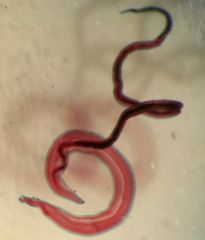
(Trematoda Digenea Stregiformes) Schistosomatidae Schistosoma mansoni
|
|
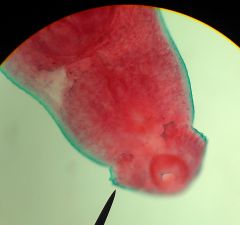
What digene body type is this?
What is/are the final host(s) of this organism? |
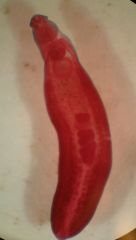
Echinostoma revolutum
body type: echinostome ducks, sometimes mammals inc. humans |
|
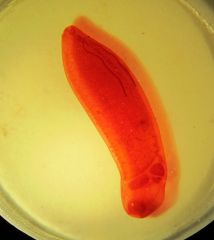
What digene body type is this?
What is/are the final host(s) of this organism? |
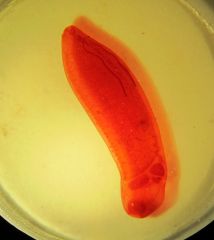
Gastrothylax elongata
paramphistome humans? |
|
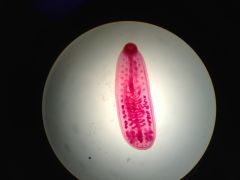
What digene body type is this?
What is(are) the final host(s) of this organism? |
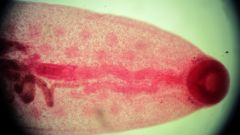
Notocotylus quinqueserialis
monostome type muskrats, voles, mice |
|
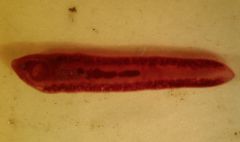
What digene body type is this?
What is(are) the final host(s) of this organism? |
Hypodereum conoidum
echinostome somehow birds, mammals inc. humans |
|
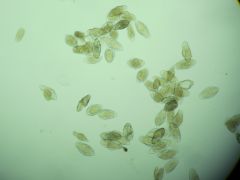
Genus species
who's eggs are these? |
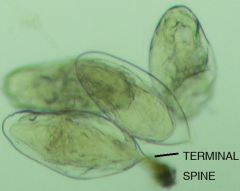
Schistosoma haematobium
You can tell by the terminal spine. |
|
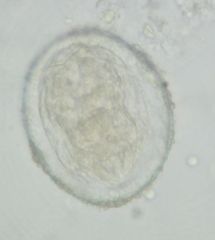
Genus species
who's eggs are these? |
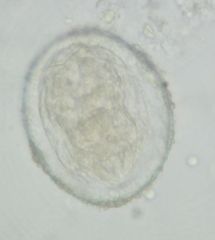
Schistosoma japonicum
They're oval/spherical |
|
|
Infrapopulation
|
The set of all parasites within a single host individual
|
|
|
Suprapopulation
|
Total individuals of parasite species in all hosts in an ecosystem (or on Earth). This can only be estimated.
|
|
|
Prevalence
|
Proportion of individuals of a host species infected at a given time, often expressed as a %
|
|
|
Abundance
|
AKA relative density. Mean number of parasites per host. Different from mean intensity because you divide by total number of hosts, not just infected hosts.
|
|
|
Incidence
|
Number of new infections per unit time divided by number of non-infected hosts at that time
|
|
|
What three classes are the four groups of Helminths sorted into and what are those?
What is their phylum? |
Class Trematoda
SC Aspidobothrea SC Digenea (Digenes) Class Monogenoidea SC Monogenea (monogenes) Class Cestoda SC Cestodaria (tapeworms) Phylum Platyhelminthese |
|
|
This subclass of Trematoda has a giant ventral sucker (w/compartments) and is of no medical or economic importance to humans.
|
Aspidobothrea
|
|
|
These are the seven basic digenic trematode body types
|
distome, monostome, gasterostome, amphistome, strigeoid, schistosome, echinostome
|
|
|
Digenic trematode body type in which ventral sucker is close to oral sucker in the anterior region of the body.
|
distome
This is the largest group of the seven. |
|
|
Digenic trematode body type without a ventral sucker. May or may not have an oral sucker.
|
monostome
|
|
|
Digenic trematode body type with only an oral sucker which is located mid-ventrally instead of at the anterior end, like all other types.
|
gasterostome
|
|
|
Digenic trematode body type where the oral and ventral sucker are at opposite ends (oral at anterior end).
|
amphistomes
|
|
|
Digenic trematode body type in which a collar of spines surrounds the oral sucker.
|
echinostomes
|
|
|
Digenic trematode body type in which a transverse equatorial constriction divides the body into a forebody with a holdfast organ and a hindbody with reproductive organs.
|
strigeoids
|
|
|
Digenic trematode body type in species that live in blood vessels of final host, and if dioecious, the males have a gynecophoric canal.
|
schistosomes
|
|
|
Technical name for "ventral sucker".
How is the ventral sucker functionally different from the oral? |
acetubular sucker, or acetabulum
The oral sucker connects to the mouth and is for eating. The ventral sucker is merely a holdfast structure. |
|
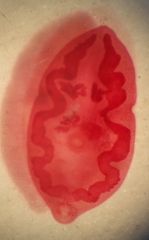
Genus species
What are the visible organs? What disease does this organism cause? |
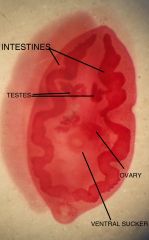
Digenic trematode
Paragonimus westermani aka oriental lung fluke Causes Paragonimiasis among east asians. 22 million/yr Infection by eating uncooked crab or crayfish. Can persist for 20 years in humans |
|

What class does this egg belong to?
|
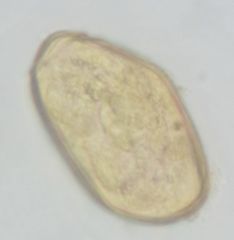
Class Trematoda, subclass Digenea
Paragonimus westermani |
|
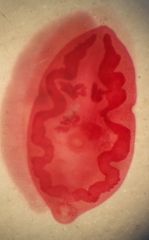
Family/Genus/Species
Intermediate host; final host mode of infection of final host location of infection geography egg description Cercaria features |
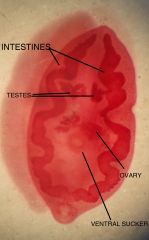
Troglotrematidae Paragonimus westermani
snail, crab/crayfish ;Humans, cats consumption of encysted crab lungs Asia, South America smaller than S. japonicum Cercaria is microcercous (has short, broad tail) |
|
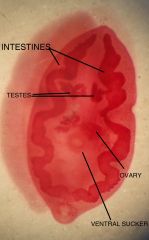
This is the general life cycle of the digenic trematode Paragonimus westermani
|
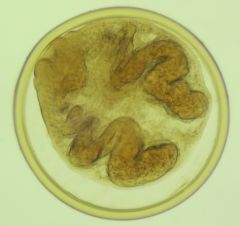
Eggs hatch in water to miracidia-infect snail-sporocyst-rediae-break out into cercaria-encyst into crayfish (metacercariae)-consumed by final host (humans, cats)- eggs coughed up and swallowed
(metacercariae pictured) |
|
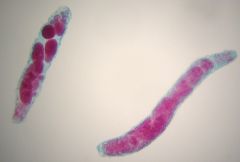
This are rediae of what species?
|
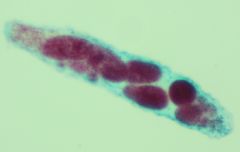
Troglotrematidae Paragonimus westermani
Developing cercariae are visible within. |
|
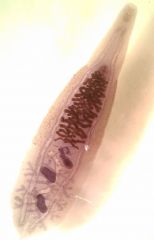
Family/Genus/Species
Intermediate host; final host mode of infection of final host location of infection geography egg description Cercaria features Adult body type |

Opisthorchiidae Clonorchis sinensis (common name: Chinese liver fluke)
snail, fish; humans , fish-eating mammals consumption of encysted fish bile duct (in liver) East Asia very small gymnocephalous Echinostome |
|
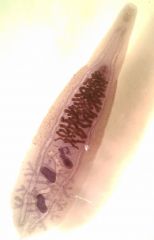
Family/Genus/Species
ID the testes, uterus, excretory bladder, ovary, and intestines |

Opisthorchiidae Clonorchis sinensis (common name: Chinese liver fluke)
|
|
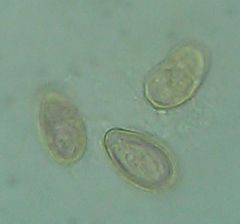
What Class do these eggs belong to?
|
Class Trematoda
Opisthorchiidae Clonorchis sinensis (common name: Chinese liver fluke) |
|
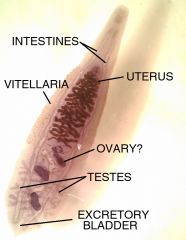
Describe the life cycle of the Chinese aka human liver fluke Clonorchis sinensis.
|
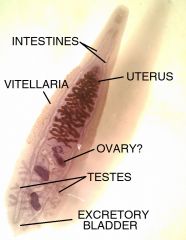
Eggs injested by snail-miracidia-sporocyst-rediae-cercariae break out and encyst in fish flesh as metacercariae-consumed by final host (humans, fish-eating mammals)
|
|
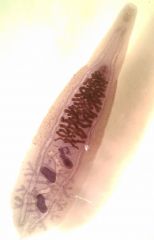
This disease of the bile ducts in the liver is named after the trematode fluke that causes it. What is the species and what is the disease?
|
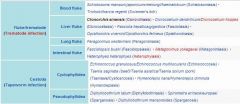
(Opisthorchiidae) Clonorchis sinensis
Clonorchiasis |
|

Family/Genus/Species
Intermediate host; final host mode of infection of final host location of infection geography egg description |

Fasciolidae Fasciolopsis buski
Snail; Pigs, Humans Consumption of metacercariae encysted vegetation (Fasciolopsiasis) small Intestine Orient smaller and thinner than F. hepatica HIGHLY branched testis |
|
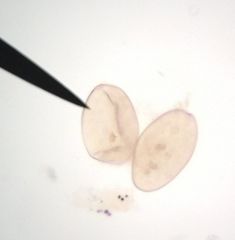
What class do these eggs belong to?
|

Class Trematoda
Fasciolidae Fasciolopsis buski |
|
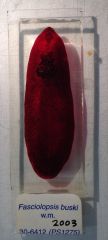
Describe the life cycle of the Fasciolidae Trematode Fasciolopsis buski
|
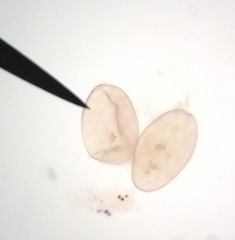
eggs hatch in water to miracidia-penetrate snail-sporocyst-rediae-cercaria-cercaria encyst into metacercaria on plant (e.g. water chestnut, Lotus)-consumed by final host (pigs, humans) and develop in intestines
|
|
|
Define Haptor.
What are the two kinds? What critters have haptors? |
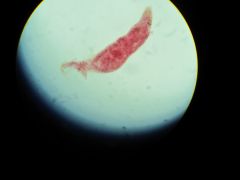
Attachment organs of monogenic trematodes with multiple suckers and hooks.
Opisthaptor (posterior end) and prohaptor (anterior end). Monogenic trematodes have haptors. |
|
|
Examples of this Class of Platyhelminthes are most often skin and gill ectoparasites of fishes.
|
Monogenoidea (subclass Monogenea)
|
|
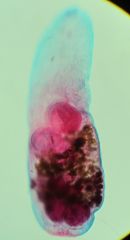
What trematode is this?
What group is it in? Identify the ovary and testes in this poor quality image. |
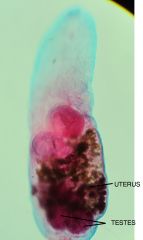
Heterophyes heterophyes
Digene |
|
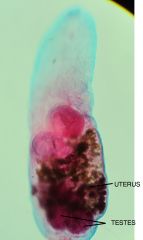
Family/Genus/Species
Intermediate hosts; final host mode of infection of final host location of infection geography egg description Cercaria features Adult body feature |
Heterophyidae Heterophyes heterophyes
snail, fish;Humans, dogs, cats, foxes and piscivorous mammals consuming raw fish Nile and Orient Contain fully developed miracidium lophocercous: longitudinal fin over dorsal side; this type of cercaria also has forked tail Genital sack has a sucker called a gonotyl |
|
|
This is the life cycle of Heterophyes heterophyes.
|
Eggs injested by snail-miracidia-sporocyst-rediae-cercariae break out and encyst in fish flesh as metacercariae-consumed by final host (humans, dogs, cats, piscivorous mammals).
|
|
|
The three types of (2 sucker) cercariae have a forked tail. Name and describe each.
What type has no sucker and a forked tail? |
forked tail = furcocercous
Lophocercous: longitudinal fin over dorsal side (ex. H. heterphyes) Apharyngeate: no pharynx Pharyngeate: has pharynx Sanguinicolid |
|
|
Type of (2 sucker) cercaria that has an oral sucker without stylet, a long tail, and is slender and simple.
|
Gymnocephalous
|
|
|
Type of (2 sucker) cercaria which has an oral sucker with a single stylet, a long tail, and may have eyespots
|
Xiphidiocercous
|
|
|
Type of (2 sucker) cercaria is "stumpy" and its oral sucker has a stylet.
|
Microcerous
|
|
|
Type of (2 sucker) cercaria with a large tail and cuplike anterior chamber containing small cercaria. oral sucker has stylet.
|
Cystophorous.
|
|
|
Type of (2 sucker) cercaria with a large body and the only type without a tail.
|
Cercariaea.
|
|
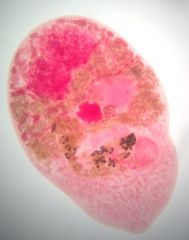
What trematode is this?
What group is it in? what disease is it associated with? |
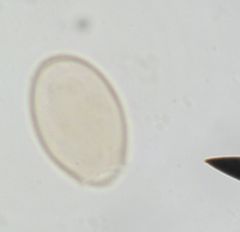
Metagonimus yokagawai aka Japanese fluke
Digene. Metagonimiasis. |
|

What trematode is this?
What group is it in? |
Dicrocoelium lanceatum
Digene |
|
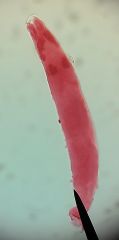
What trematode is this?
What group is it in? |
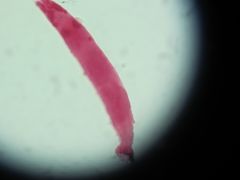
Gyrodactylus sp.
Monogene. Opisthaptor visible at posterior end. Parasite of fish/gills. |
|
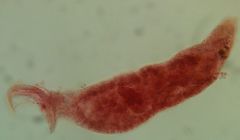
What trematode is this?
What group is it in? |
Urocleidus sp.
Monogene. You can see the Opisthaptor, 3 rows of clamps |
|

What trematode is this?
What group is it in? |

Microcotyle sebastis.
2 rows of clamps on the opisthaptor (pictured) |
|

What trematode genus is this?
What group is it in? |
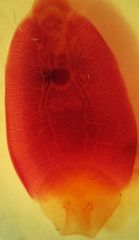
Entobdella.
Monogene. Flatfish ectoparasite |
|
|
What species causes the disease Metagonimiasis? Mode of infection?
|
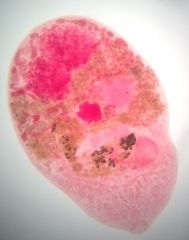
The digene Metagonimus yokagawai aka Japanese fluke.
Eating uncooked fish. parasite of the intestine. Symptoms include abdominal pain and diarrhea. |
|
|
What species causes the disease Schistosomiasis aka Billharzia? Mode of infection?
|
The digene trematodes Schistosoma japonicum/haematobium/mansoni.
Swimming in water containing S. cercariae. Haematobium causes urinary type, the others, intestinal. Disease present in mummies, ancient documentation. Kills half a million people/year. Asian carp that eats snails also a vector control. Drug Praziquantel used to treat. |
|
|
"Liver rot" caused by Fasciola hepatica.
|
Fascioliasis
Humans get it through consumption of watercress Est 17% of cattle in Montana have this parasite |
|
|
Identify and describe the four basic body parts of cestodes.
|
Scolex: "head" for attachment and locomotion. Often has hooks or suckers. Has rostellum, a small protuberance or beak, especially the fleshy protuberance of the scolex (mouth) of a tapeworm, which may or may not bear hooks
Neck: aka acetabulum, cups for holding, muscular grabbing. if present, zone of tissue proliferation. Not segmented. Strobila: the chain of proglottids that bud from the neck or scolex |
|
|
Monozoic vs polyzoic
|
monozoic cestoids have only one proglottid (genitalium)
|
|
|
Metacestode
|
a stage of a tapeworm occurring in an intermediate host ; a larval tapeworm
|
|
|
Describe the general cestode life cycle
|
Oncosphere - embryo. Sometimes hatch and go swimming with cilia, becoming coracidia
Metacestode - fig 20.23 juvenile with a scolex Procercoid - once eaten, coracidia becomes this. Plerocercoid - after procercoid , last larval form |
|
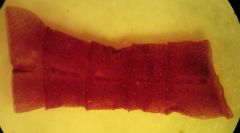
These are proglottids of what cestode species?
|
(Diphyllobothriidae) Diphyllobothrium latum.
Can cause Diaphyllobothriasis in humans (or bears etc). Human will typically get it from drinking stream water and ingest copepod form Sparganosis you get from eating the copepod. Can go anywhere in body because parasite is "meant" to be in a fish not a human |
|
|
Bothria
|
(cestodes) Bothria are muscular grooves that provide attachment by pinching host tissue between them.
|
|
|
Bothridia
|
(cestodes) Bothridia are semicircular, muscular structures that act by pinching host tissue. Look like suckers, but are horseshoe-shaped not circular
|
|
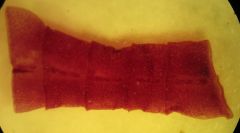
Family/Genus/Species
Intermediate hosts; final host mode of infection of final host location of infection geography egg description Adult body feature |
(Diphyllobothriidae) Diphyllobothrium latum aka fish tapeworm
copepods, fish; fish eating carnivors, humans consuming raw fish intestines North America, Finland small, round eggs 9m long, almond shaped scolex with pair of suctorial grooves (bothria) and a short neck connecting proglottids |
|
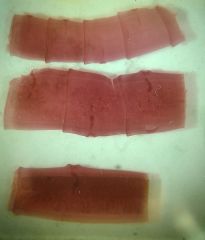
Family/Genus/Species
Intermediate hosts; final host mode of infection of final host location of infection geography egg description Adult body feature |
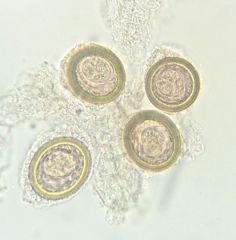
(Taeniidae) Teania saginata aka beef tapeworm
cow;human intestines Very small and round scolex is unarmed |
|
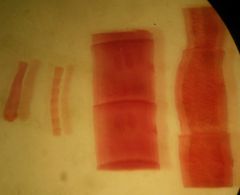
Family/Genus/Species
Intermediate hosts; final host mode of infection of final host location of infection Adult body feature |
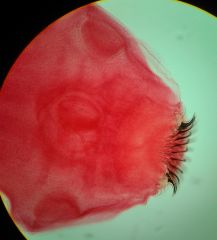
(Taeniidae) Taenia pisiformis aka dog tapeworm
rabbit; dogs/canids consuming cysticerci in rabbit intestines 100cm long with large rostellum with many hooks of two sizes. |
|
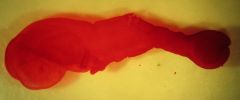
Which cestode does this cystercus belong to?
|
(Taeniidae) Taenia pisiformis aka dog tapeworm
|
|
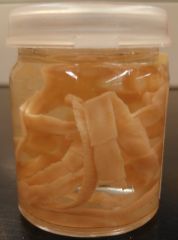
This is an adult...
|
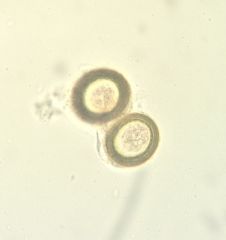
(Taeniidae) Taenia pisiformis aka dog tapeworm.
Eggs of T. pisiformis pictured above. |
|

Family/Genus/Species
Intermediate hosts; final host mode of infection of final host location of infection geography Adult body feature |
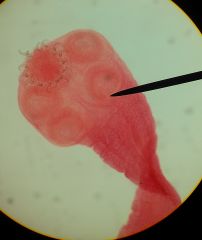
(Taeniidae) Taenia solium aka pig tapeworm
pig;human intestines 22-32 hooks of two sizes on the scolex very dangerous for humans to get the eggs, humans are not int. host |
|

Family/Genus/Species
Intermediate hosts; final host mode of infection of final host location of infection geography eggs Adult body feature |
(Taeniidae) Echinococcus granulosus
ungulates, Humans; canidae humans can injest larval hydatid in the liver small intestines (in humans, larva encyst in liver) Worldwide very small and round Very small, 5mm. Adults have scolex and neck followed by 4 proglottids |
|
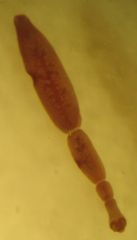
Life cycle of the cestode (Taeniidae) Echinococcus granulosus
|
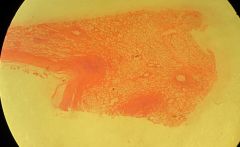
Adult worms in intesting of wild/domestic canids egg passed in excrement. Egg eaten by sheep/human-oncosphere pentrates gut to organs-hydratid cysts form in organs-canid eats cysts and adult matures
Pictured are cysts, apparently. |
|
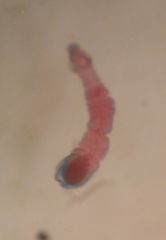
Family/Genus/Species
Intermediate hosts; final host mode of infection of final host location of infection geography |
(Taeniidae) Echinococcus multilocularis
field mice; canidae, foxes, cats Eurasia, Europe, NorthAmerica |
|
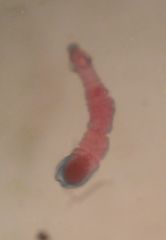
Life cycle of the cestode (Taeniidae) Echinococcus multilocularis
|
Canids excrete eggs, ungulates/rodents eat eggs (sometimes humans,but humans inadvertent host) oncosphere pentrates gut to organs-hydratid cysts form in organs-canid eats cysts and adult matures
|
|
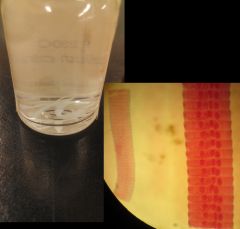
Family/Genus/Species
Intermediate hosts; final host mode of infection of final host Adult body feature |

(Dilepididae) Dipylidium caninum aka dog tapeworm
flees, lice; dogs, cats, humans scolex has retractable rostellum with ceveral circles of rose thorn hooks |
|
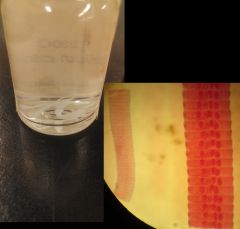
Life cycle of the cestode (Dilepididae) Dipylidium caninum
|
Egg in proglottid eaten by juvenile flea and hatch into oncospheres-develop into cysticercoid-final host eats flea
|
|
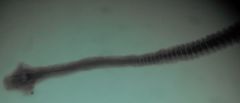
Life cycle of the cestode (Hymenolepididae) Hymenolepis nana
|
Egg in proglottid eaten by juvenile flea and hatch into oncospheres-develop into cysticercoid-final host eats flea
Can be direct. If ingested by final host, oncospheres freed from eggs in intestine, they then burrow into villi and develop into cysticercoids. Up to 21% of US children have Hymenolepiasis. |
|
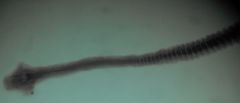
Family/Genus/Species
Intermediate hosts; final host mode of infection of final host location of infection Adult body feature |
(Hymenolepididae) Hymenolepis nana aka Dwarf tapeworm
insects (int host optional); final is always rodents and humans consumption of eggs intestines 10cm with globular colex with retractile rostellum of 20-30 hooks. Strobila consists of 200 proglottids that are broader than long Up to 21% of US children have Hymenolepiasis. |
|

Family/Genus/Species
Intermediate hosts; final host Adult body feature |
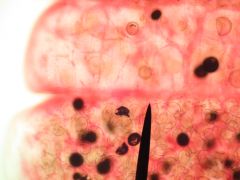
(Hymenolepididae) Hymenolepis diminuta aka rat tapeworm
diminuta insect (beetle) ;rats and humans lacks armed rostellum and the scolex has a small apical organ (Gravid proglottid pictured) |
|
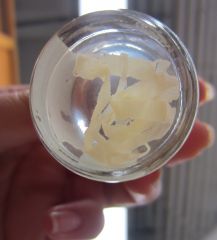
Family/Genus/Species
Intermediate hosts; final host mode of infection of final host location of infection egg type Adult body feature |
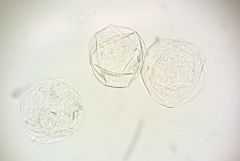
Anoplocephalidae Moniezia expansa
soil mites; herbivorous animals: sheep, goats, cattle injesting mites laden with cysticercoids intestines World Wide triangular eggs 600cm legnth with four prominent suckers, but no rostellum and hooks |
|
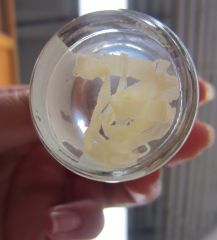
Life cycle of the cestode (Anoplocephalidae) Moniezia expansa
|
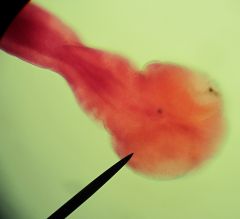
Eggs injested by soil mites from proglottids-ocospheres bore into intestine of mite and become cysticercoids-mites swallowed by grazer to mature
|
|
|
Metraterm
|
muscular spewer of eggs at end of uterus in a flatform
|

